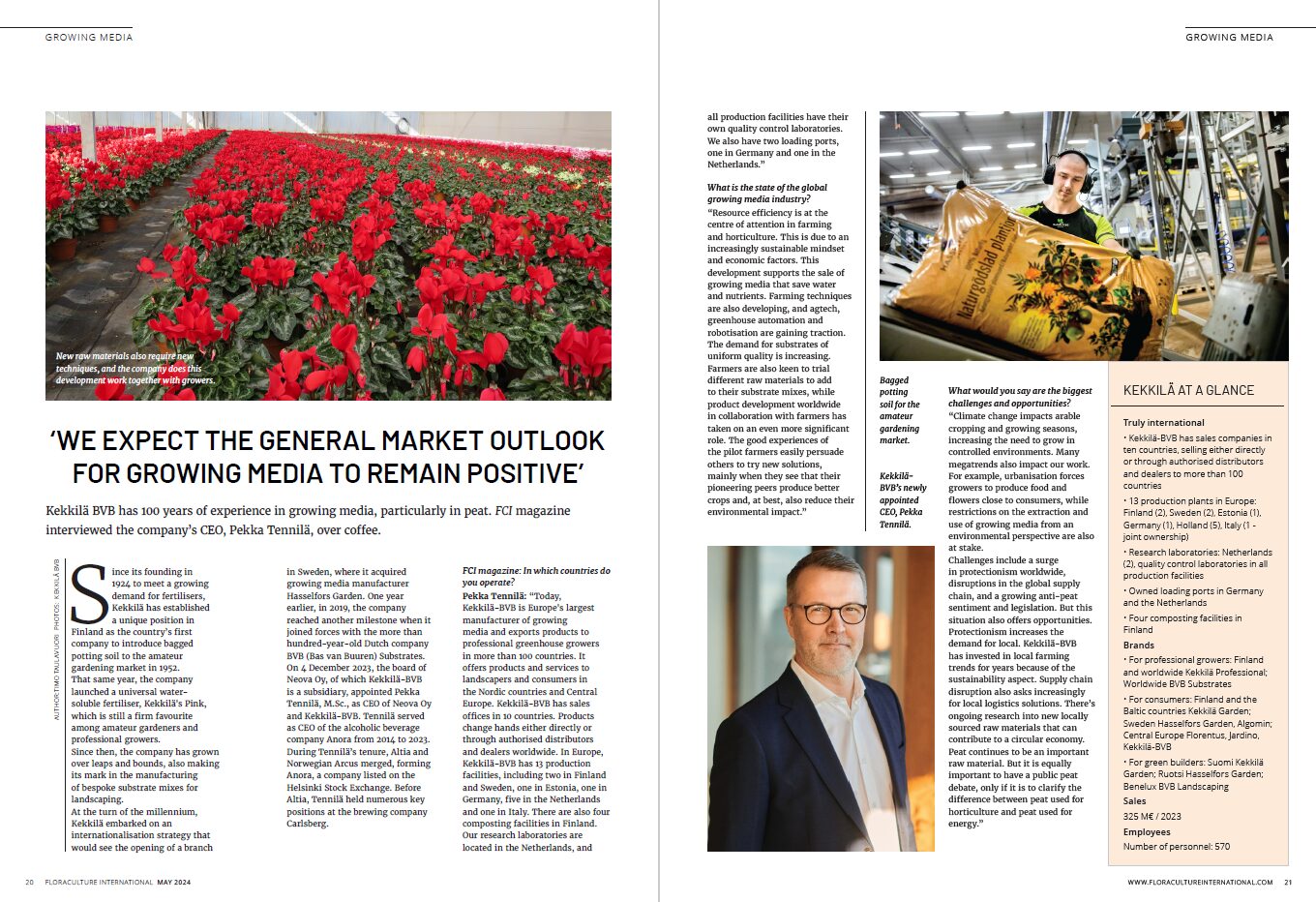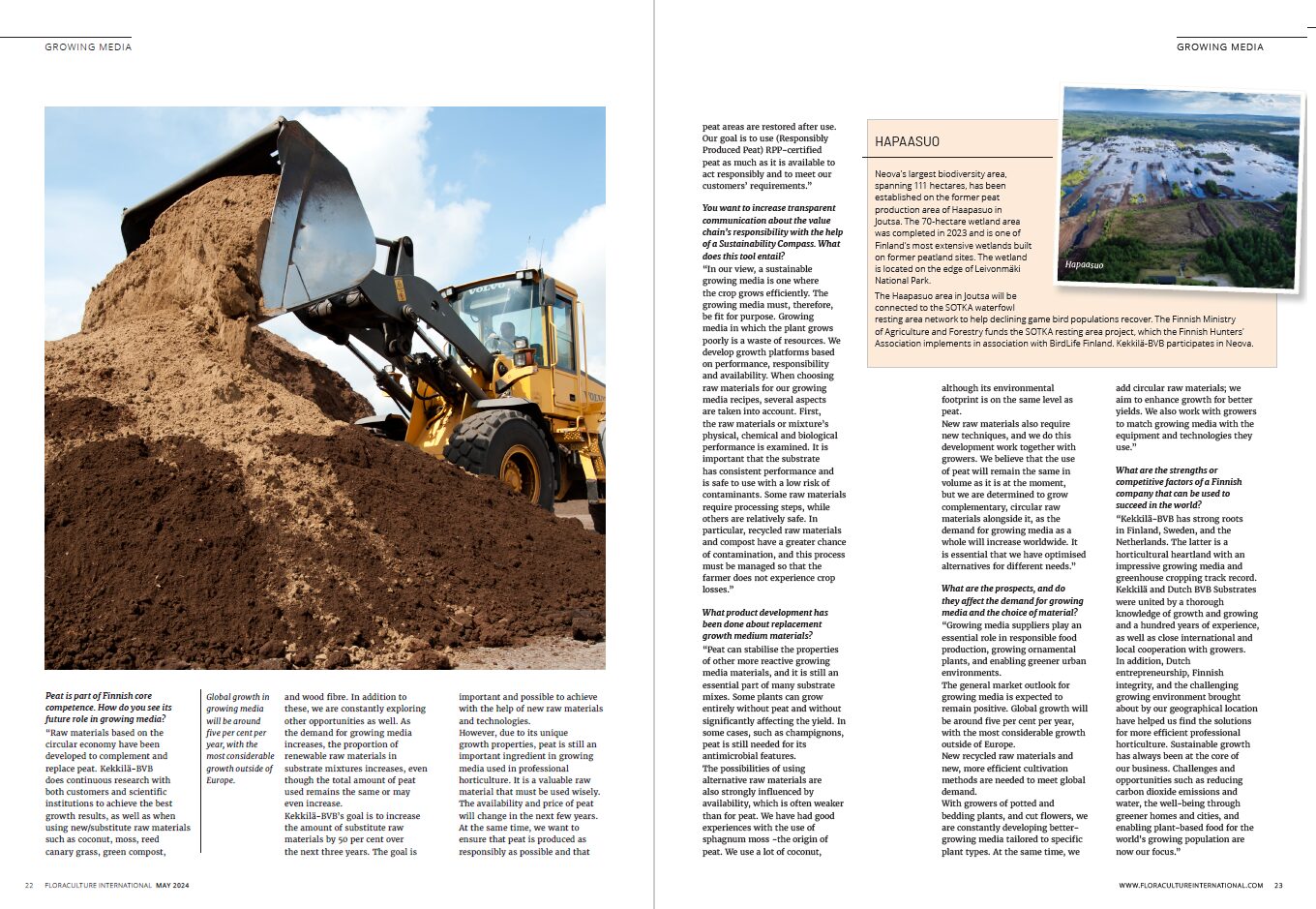‘We expect the general market outlook for growing media to remain positive’
This article was published originally by FloraCulture International in their Digital magazine, May 2024 edition. Author: Timo Taulavuori.
FloraCulture International encourages the pursuit of joint activities in areas of mutual interest with national, and international societies, and organisations. Agreements have been reached between FCI and leading growers and trade associations worldwide.

Kekkilä BVB has 100 years of experience in growing media, particularly in peat. FCI magazine interviewed the company’s CEO, Pekka Tennilä, over coffee.
Since its founding in 1924 to meet a growing demand for fertilisers, Kekkilä has established a unique position in Finland as the country’s first company to introduce bagged potting soil to the amateur gardening market in 1952. That same year, the company launched a universal water-soluble fertiliser, Kekkilä’s Pink, which is still a firm favourite among amateur gardeners and professional growers. Since then, the company has grown over leaps and bounds, also making its mark in the manufacturing of bespoke substrate mixes for landscaping.
At the turn of the millennium, Kekkilä embarked on an internationalisation strategy that would see the opening of a branch 20in Sweden, where it acquired growing media manufacturer Hasselfors Garden. One year earlier, in 2019, the company reached another milestone when it joined forces with the more than hundred-year-old Dutch company BVB (Bas van Buuren) Substrates.
On 4 December 2023, the board of Neova Oy, of which Kekkilä-BVB is a subsidiary, appointed Pekka Tennilä, M.Sc., as CEO of Neova Oy and Kekkilä-BVB. Tennilä served as CEO of the alcoholic beverage company Anora from 2014 to 2023. During Tennilä’s tenure, Altia and Norwegian Arcus merged, forming Anora, a company listed on the Helsinki Stock Exchange. Before Altia, Tennilä held numerous key positions at the brewing company Carlsberg.
FCI magazine: In which countries do you operate?
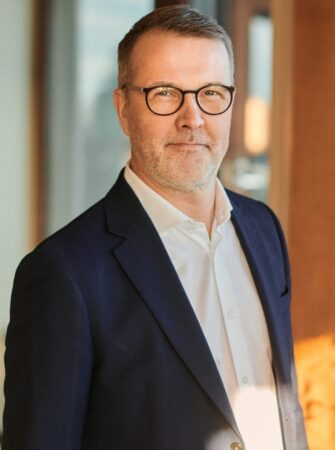 Pekka Tennilä: “Today, Kekkilä-BVB is Europe’s largest manufacturer of growing media and exports products to professional greenhouse growers in more than 100 countries. It offers products and services to landscapers and consumers in the Nordic countries and Central Europe. Kekkilä-BVB has sales offices in 10 countries. Products change hands either directly or through authorised distributors and dealers worldwide. In Europe, Kekkilä-BVB has 13 production facilities, including two in Finland and Sweden, one in Estonia, one in Germany, five in the Netherlands and one in Italy. There are also four composting facilities in Finland. Our research laboratories are located in the Netherlands, and all production facilities have their own quality control laboratories. We also have two loading ports, one in Germany and one in the Netherlands.
Pekka Tennilä: “Today, Kekkilä-BVB is Europe’s largest manufacturer of growing media and exports products to professional greenhouse growers in more than 100 countries. It offers products and services to landscapers and consumers in the Nordic countries and Central Europe. Kekkilä-BVB has sales offices in 10 countries. Products change hands either directly or through authorised distributors and dealers worldwide. In Europe, Kekkilä-BVB has 13 production facilities, including two in Finland and Sweden, one in Estonia, one in Germany, five in the Netherlands and one in Italy. There are also four composting facilities in Finland. Our research laboratories are located in the Netherlands, and all production facilities have their own quality control laboratories. We also have two loading ports, one in Germany and one in the Netherlands.
What is the state of the global growing media industry?
Resource efficiency is at the centre of attention in farming and horticulture. This is due to an increasingly sustainable mindset and economic factors. This development supports the sale of growing media that save water and nutrients. Farming techniques are also developing, and agtech, greenhouse automation, and robotisation are gaining traction. The demand for substrates of uniform quality is increasing. Farmers are also keen to trial different raw materials to add to their substrate mixes, while product development worldwide in collaboration with farmers has taken on an even more significant role. The good experiences of the pilot farmers easily persuade others to try new solutions, mainly when they see that their pioneering peers produce better crops and, at best, also reduce their environmental impact.
What would you say are the biggest challenges and opportunities?
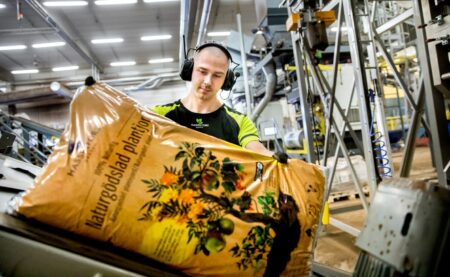 Climate change impacts arable cropping and growing seasons, increasing the need to grow in controlled environments. Many megatrends also impact our work. For example, urbanisation forces growers to produce food and flowers close to consumers, while restrictions on the extraction and use of growing media from an environmental perspective are also at stake.
Climate change impacts arable cropping and growing seasons, increasing the need to grow in controlled environments. Many megatrends also impact our work. For example, urbanisation forces growers to produce food and flowers close to consumers, while restrictions on the extraction and use of growing media from an environmental perspective are also at stake.
Challenges include a surge in protectionism worldwide, disruptions in the global supply chain, and a growing anti-peat sentiment and legislation. But this situation also offers opportunities. Protectionism increases the demand for local. Kekkilä-BVB has invested in local farming trends for years because of the sustainability aspect. Supply chain disruption also asks increasingly for local logistics solutions. There’s ongoing research into new locally sourced raw materials that can contribute to a circular economy.
Peat continues to be an important raw material. But it is equally important to have a public peat debate, only if it is to clarify the difference between peat used for horticulture and peat used for energy.
Peat is part of Finnish core competence. How do you see its future role in growing media?
Raw materials based on the circular economy have been developed to complement and replace peat. Kekkilä-BVB does continuous research with both customers and scientific institutions to achieve the best growth results, as well as when using new/substitute raw materials such as coconut, moss, reed canary grass, green compost, and wood fibre. In addition to these, we are constantly exploring other opportunities as well. As the demand for growing media increases, the proportion of renewable raw materials in substrate mixtures increases, even though the total amount of peat used remains the same or may even increase.
Kekkilä-BVB’s goal is to increase the amount of substitute raw materials by 50 per cent over the next three years. The goal is important and possible to achieve with the help of new raw materials and technologies. However, due to its unique growth properties, peat is still an important ingredient in growing media used in professional horticulture. It is a valuable raw material that must be used wisely. The availability and price of peat will change in the next few years. At the same time, we want to ensure that peat is produced as responsibly as possible and that peat areas are restored after use. Our goal is to use RPP-certified peat as much as it is available to act responsibly and to meet our customers’ requirements.
You want to increase transparent communication about the value chain’s responsibility with the help of a Sustainability Compass. What does this tool entail?
In our view, sustainable growing media is one where the crop grows efficiently. The growing media must, therefore, be fit for purpose. Growing media in which the plant grows poorly is a waste of resources. We develop growth platforms based on performance, responsibility, and availability. When choosing raw materials for our growing media recipes, several aspects are taken into account. First, the raw materials or mixture’s physical, chemical, and biological performance is examined. It is important that the substrate has consistent performance and is safe to use with a low risk of contaminants. Some raw materials require processing steps, while others are relatively safe. In particular, recycled raw materials and compost have a greater chance of contamination, and this process must be managed so that the farmer does not experience crop losses.
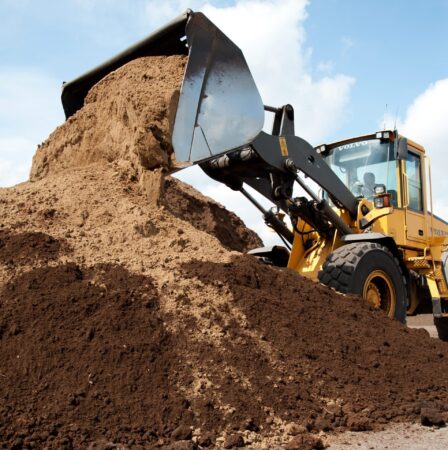
What product development has been done about replacement growth medium materials?
Peat can stabilise the properties of other more reactive growing media materials, and it is still an essential part of many substrate mixes. Some plants can grow entirely without peat and without significantly affecting the yield. In some cases, such as champignons, peat is still needed for its antimicrobial features. The possibilities of using alternative raw materials are also strongly influenced by availability, which is often weaker than for peat. We have had good experiences with the use of sphagnum moss – the origin of peat. We use a lot of coconut, although its environmental footprint is on the same level as peat. New raw materials also require new techniques, and we do this development work together with growers. We believe that the use of peat will remain the same in volume as it is at the moment, but we are determined to grow complementary, circular raw materials alongside it, as the demand for growing media as a whole will increase worldwide. It is essential that we have optimised alternatives for different needs.
What are the prospects, and do they affect the demand for growing media and the choice of material?
Growing media suppliers play an essential role in responsible food production, growing ornamental plants, and enabling greener urban environments. The general market outlook for growing media is expected to remain positive. Global growth will be around five per cent per year, with the most considerable growth outside of Europe. New recycled raw materials and new, more efficient cultivation methods are needed to meet global demand. With growers of potted and bedding plants, and cut flowers, we are constantly developing better-growing media tailored to specific plant types. At the same time, we add circular raw materials; we aim to enhance growth for better yields. We also work with growers to match growing media with the equipment and technologies they use.
What are the strengths or competitive factors of a Finnish company that can be used to succeed in the world?
Kekkilä-BVB has strong roots in Finland, Sweden, and the Netherlands. The latter is a horticultural heartland with an impressive growing media and greenhouse cropping track record. Kekkilä and Dutch BVB Substrates were united by a thorough knowledge of growth and growing and a hundred years of experience, as well as close international and local cooperation with growers. In addition, Dutch entrepreneurship, Finnish integrity, and the challenging growing environment brought about by our geographical location have helped us find the solutions for more efficient professional horticulture. Sustainable growth has always been at the core of our business. Challenges and opportunities such as reducing carbon dioxide emissions and water, well-being through greener homes and cities, and enabling plant-based food for the world’s growing population are now our focus.
This article was published originally by FloraCulture International in their Digital magazine, May 2024 edition. Author: Timo Taulavuori.
FloraCulture International encourages the pursuit of joint activities in areas of mutual interest with national, and international societies, and organisations. Agreements have been reached between FCI and leading growers and trade associations worldwide.
